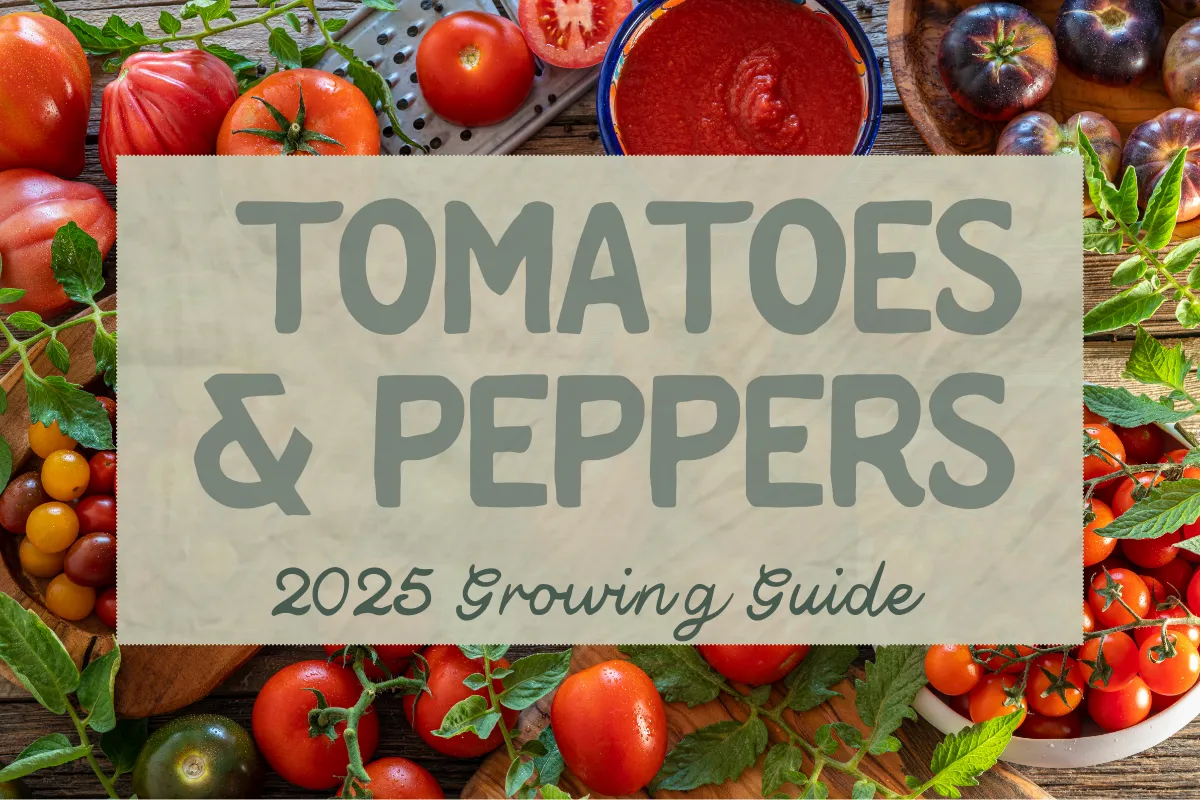
All About: Tomatoes and Friends

🍅 All About Tomatoes, Peppers, Eggplants & Tomatillos
Your essential guide to growing the boldest flavors in the mountain garden.

🧬 Family Traits: What These Plants Share
The Solanaceae squad needs heat, patience, and nutrient-rich soil—but rewards you with bold summer flavor.
Shared characteristics:
Warm-season, frost-sensitive crops
Thrive in full sun with rich, well-drained soil
Heavy feeders needing consistent water and compost
Prone to shared pests and diseases—rotate crops!
High drama, high payoff

🪴 How to Grow in Mountain Conditions

🌱 Seed Starting
Start indoors 10–12 weeks before last frost (late Feb/early March in Eagle)
Use heat mats to maintain 70–80ºF for germination
Sow in blocks or pots, under strong light

🌦️ Sowing & Transplanting
Harden off for 5–7 days before planting
Transplant when nights stay above 45ºF
Space plants 18–24” apart

🍽️ Feeding & Soil Support
Amend holes with compost + organic fertilizer
Water deeply and consistently
Mulch to retain moisture and reduce soil splash
✂️ Harvesting
Tomatoes: Pick at full color with slight give
Peppers: Green or ripened for max flavor
Eggplants: Glossy and firm before seeds harden
Tomatillos: Harvest when husk splits
🥕 The Veggies in This Group
Eggplant
Challenging but rewarding in mountain gardens.
Annina:
Hot Peppers
Need full sun and consistent warmth.
Anaheim:
Czech Black:
Early Jalapeño:
Purple Jalapeño:
Hidalgo Serrano:
Matchbox (Small Chili):
Sweet Bell Peppers
Tricky in short seasons but worth the effort.
Revolution Bell:
Takii’s New Ace:
Mini Red/Yellow:
Semi-Sweet Peppers
Best known for shishitos—easy and flavorful.
Resilient Shishito:
Cubanelle:
Jimmy Nardello’s:
Specialty Peppers
🌱 Varieties:
Greek Pepperoncini:
Klari Baby Cheese:
🍅 Tomatoes
Tomatoes are divided by growth habit and fruit size/class.
Growth Habit:
Determinate:These grow, flower, and fruit in one flush. They’re compact and great for small spaces. No pruning needed—just remove late flowers toward season’s end to focus energy on ripening.
Indeterminate:These grow and fruit continuously until frost. They require strong support and benefit from optional pruning for larger fruit. Top plants late in the season to encourage ripening.
Fruit Classes:
Small Fruited:Cherry or grape-sized; ripen fast; perfect for short seasons.
Early:2–3 bite-sized, often red, tolerant of cool nights. Set fruit without pollinators—great for unpredictable springs.
Slicer:Sandwich-sized tomatoes including heirlooms and beefsteaks. Require the longest season to ripen.
Paste:Meaty with low moisture—ideal for sauces and drying. Still delicious fresh.
🌾 Seed Saving
Scoop seeds from ripe fruit, ferment to remove gel, rinse, and dry thoroughly.
🌱 Varieties We’re Growing:
Small Fruited:
Sun Gold: Indeterminate. Sweet/tangy apricot-orange cherry. Craveable and wildly productive.
Honeydrop: Indeterminate. Yellow-orange, crack-resistant, sweet like Sunsugar.
Lucia: Indeterminate. Tart-sweet red grape with crunchy skin.
Peacevine: Indeterminate. Red clusters bred from Sweet 100, open-pollinated.
Lizzano: Semi-determinate. Sweet, compact cherry. Great for containers. AAS Winner.
Early:
Glacier: Determinate. Red, 1–2", potato-leaf foliage. Cold-hardy and flavorful.
Beaverlodge: Determinate. Compact and creeping, ideal for containers. Super productive.
Stupice: Indeterminate. Slightly oval, red fruit. Sweet, prolific, and cold-tolerant.
Slicer:
Cherokee Purple: Indeterminate. Dusky purple heirloom. Rich, sweet, winey flavor.
Black Prince: Indeterminate. Garnet-colored, smooth and uniform.
Green Zebra: Indeterminate. Green with stripes. Tart-sweet and salad-perfect.
Japanese Trifele: Indeterminate. Mahogany pears with complex, sweet flavor.
Mountain Spirit: Indeterminate. Yellow-red bicolor bred in Carbondale, CO. Vigorous and fruity.
Berkeley Pink Tie-Dye: Compact indeterminate. Bi-lobed, striped, tangy, and early. A stunner!
Paste:
Orange Banana: Indeterminate. Sweet and fruity. Best for drying or sauces.
Heinz 2653: Determinate. Firm and fast-ripening. Ideal for canning.
🌮 Tomatillos & Friends
Need at least two plants to fruit (self-incompatible) and benefit from support structures.
🌾 Seed Saving
Let fruits mature, remove husk, scoop and rinse seeds, and dry thoroughly.
🌱 Varieties We’re Growing:
Aunt Molly’s Ground Cherry (Physalis pruinosa):Polish heirloom. Tropical-flavored golden fruits. On the Slow Food Ark of Taste.
Purple Blush (Physalis ixocarpa):Large fruits. Sun-blushed purple skin. Roast with pumpkin seeds for a rich salsa.
Purple Tomatillo:Deep purple skin. Decorative and delicious in salsa verde.
Queen of Malinalco:3" yellow fruits with sweet, tropical flavor. Great fresh or roasted. From Aztec town of Malinalco.
🍴 From Garden to Table: Why They Matter
These Solanaceae staples bring color, spice, and depth to your summer cooking. Think salsa verde, ratatouille, roasted sauces, or stuffed peppers—and they preserve beautifully too.
Preserving Tips:
Roast and freeze for sauces
Pickle, ferment, or dry peppers
Puree roasted eggplant for sauces and dips
Make salsa verde or jam from tomatillos
Want help choosing varieties or planning your Solanaceae strategy? Come chat with us at Wiggle Worm Gardens—we love helping you turn heat-loving drama queens into your summer garden heroes. 🌞🍅🌶️🍆
Key Takeaways
Learn how to grow heat-loving crops like tomatoes, eggplants, and peppers in cool-climate mountain gardens
Explore seed starting, transplanting, and feeding methods for Solanaceae success
Discover mountain-friendly tomato varieties from cherry to slicer to paste
Get tips on seed saving, trellising, and frost protection for long-season flavor
Preserve summer’s bounty through roasting, freezing, fermenting, and drying
